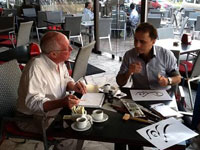Calligraphy: the art that's a casualty of modern times
 Dr Jamal Naja (on the left) is showing the basics of Islamic calligraphy
Dr Jamal Naja (on the left) is showing the basics of Islamic calligraphy
Dr Jamal Naja meets Robert Fisk in a coffee shop just down the road from his home in Alamuddin Street, a quiet, almost mischievous face, greying hair, and he lays — with great care — a black packet on the table in front of him.
Tripoli in northern Lebanon is an overwhelmingly Muslim city and Naja has a PhD in Islamic studies. But he is also a calligrapher and the black packet contains his pens and brushes. «Now, Robert, take these two pencils and drop them on the floor.» One sounds low and hollow. The other sounds high and brittle. «The higher the note, the better the pencil,» he says.
Calligraphy is an Islamic rather than a mere Arabic form of art, partly because Muslims disapprove of the human image in religious work. Iran has at least 200 calligraphers but in Beirut, it is a dying art — Naja is one of 10 authentic calligraphers left — and the computer is slowly destroying these craftsmen.
Naja picks a sheaf of glossy, bright pages and a tiny inkpot and his pens and pencils scream over the surface as if they are alive, louder than chalk on a blackboard.
Naja copies out a surah from the Quran and his pen screams and squeaks and screams, his script moving up and down the page, bottom to top, measured in the number of little «diamonds» — five at the most — and their place within and below the consonants, usually indicating vowels. In the past, this was also the language of government, of Ottoman Firmans and of authority. The ink is special, and they say it smells of oranges.
Naja calls his work «the trade of honour» — 200 years ago, anyone who was literate would want to write like this, not only as a proof of power, but of learning. How typical that our laptops are now destroying the literacy of the past.
he Prophet, famously, was himself illiterate — his words were copied down later — but Naja adds that «illiteracy does not mean lack of education — the Prophet was wise and spoke to calligraphers».
In olden times, they would receive a certificate of calligraphy, a practice that has now largely disappeared, although Naja himself has won international awards in calligraphy and has been a judge of calligraphic art. The Diwani script in which he is writing was developed under the Ottoman empire and perhaps the most famous calligraphy — still found on old fountains in Beirut — is the Ottoman official seal.
Naja is a serious man — you’d have to be to write like this — but he enjoys life as a university professor in Beirut. «I pray, of course, but I am an open person. I enjoy all countries and all civilization. Islam is a moderate religion, not a fundamentalist one. It is a mix and an integration of civilizations.»
Alas, that will not maintain the calligraphers of the Middle East. Some earn their living today (though not Naja) by writing out restaurant menus or inscribing dinner menus for presidents. It seems a sad outcome of this age-long of art.
Naja has started to work on another sheet of paper and the screaming pen begins again. There is a silk ribbon through the pen and that is what is screaming, the ink running on to the material as the pressure of the pen is applied to the silk.
Source: Belfast Telegraph, The Independent
Calligraphy is a kind of music not for the ears, but for the eyes.
(V. Lazursky)



